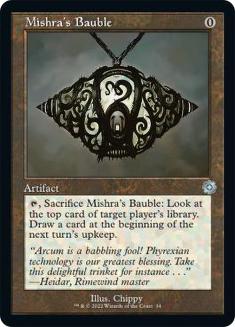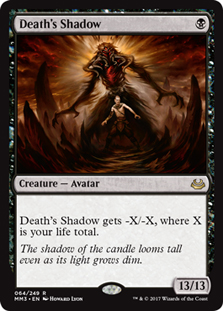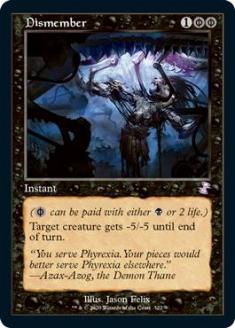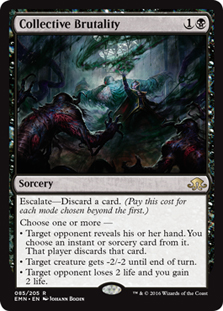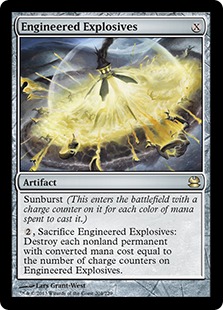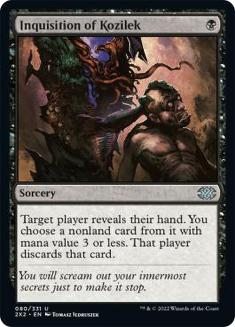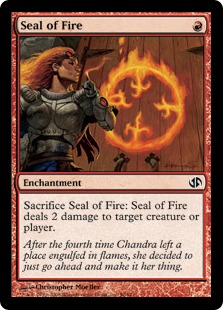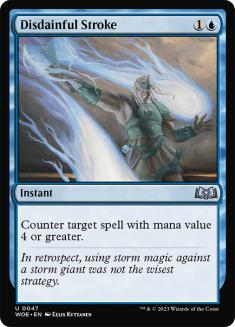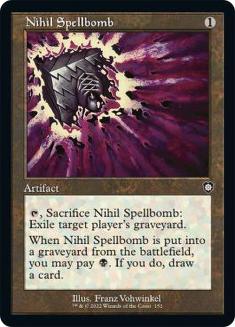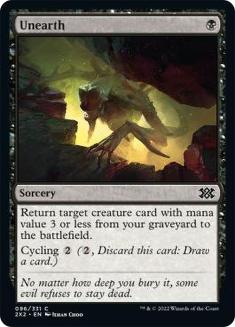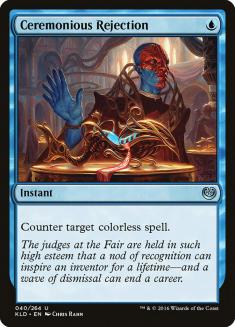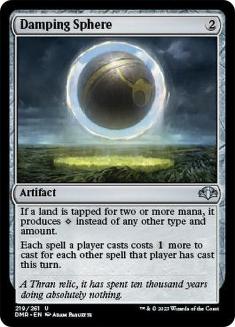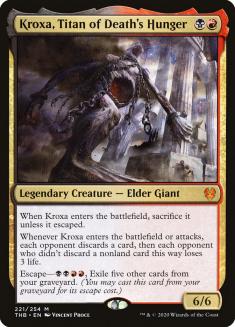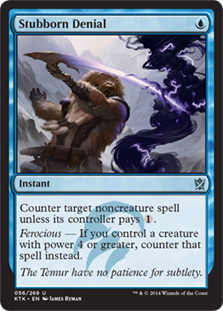Lurrus of the Dream-Den is an absurd Magic card. There’s no doubt about it. The fact that, even in Vintage, Lurrus is in the conversation for best card in the format speaks volumes. It has a totally surmountable restriction, acts as an eighth card in an opening hand, and works as an Eternal Witness every single turn. It’s patently broken.
And, just to make sure we understand this exercise that seems to come back with the release of every new set: What do we say when we see a card so broken that it’s likely to get banned in every format?
Play this card until it gets banned.
Play Lurrus everywhere. It will get banned soon and you will regret not having played it. In Modern, there are a number of decks that can incorporate it, but the best one invariably will play the cheapest synergistic pieces to make Lurrus a monster.
First on the list is Mishra’s Bauble, of course, and the second place to look is one-mana creatures. Well, Burn can play Bauble at little cost, and also runs fourteen or more cheap creatures to recur with Lurrus. It’s essentially a freeroll, which is pretty incredible for a deck that relies on having a high quantity of raw cards to drag twenty points of damage out.
But a recursive threat in a deck that sometimes runs up dry on actual game-enders due to lack of threat density? A piece of card advantage built into a pile of one-for-ones? We must be talking about Death’s Shadow here.
And yes, Death’s Shadow decks are essentially the best place for Lurrus, which fills a lot of the holes that existed in the strategy for years.
1. It’s an extra card, and more, a discard-proof threat.
For all the virtual ink that’s been spilled over the last three years regarding the various builds of Death’s Shadow (and specifically Grixis Death’s Shadow), the biggest weakness the deck has is a lack of threat density. It usually plays a mere eight cards that are genuinely capable of winning a game, and without Legacy-quality cantrips to find these threats, there are a small subset of games where your deck simply does not find a way to actually kill the opponent in time. Generally they recover from your early disruption to overpower you while you flood out.
Certainly with Jund Death’s Shadow and its copies of Traverse the Ulvenwald, it was easier for that particular build to find enough threats to fight through removal and keep applying pressure. And Kolaghan’s Command or Liliana, the Last Hope offered ways to bring back Thought Scour-ed Gurmag Anglers or Death’s Shadows. The London Mulligan helped here, too, bringing new levels of consistency to the deck to ameliorate this weakness.
But with Lurrus (along with another powerful threat from recent times) it’s easier than ever to find threats and keep them coming back for more.
The Death’s Shadow mirrors often involved one player topdecking a threat after all the other ones were discarded or destroyed with Dismember or Fatal Push. Now, Lurrus means that at a certain point in the mid-game, both players have the opportunity to present multiple threats in the same turn when they feel the time is right to “go for it.”
2. It’s a source of recursion for your other threats.
The new versions of Death’s Shadow decks are more reliant on graveyard recursion than most. Obviously, by packing Lurrus in your deck you’re immediately demonstrating a desire to bring back your dead creatures, but Grixis Death’s Shadow goes further than most. It packs Unearth and Kolaghan’s Command, both of which return Snapcaster Mages and keep the circle of cards flowing. In Lurrus matchups, often the deck with the ability to ensure the one Lurrus does not get permanently destroyed will win. That is great news for Grixis Death’s Shadow, which has a handful of ways to bring back the Cat Nightmare, then bring back another threat, and keep chaining rebuilt battlefields.
Lurrus means you get to draw extra cards every turn (with Mishra’s Bauble), present unrelenting threats every turn (with Death’s Shadow) and even come up with removal spells turn after turn (with Seal of Fire). This is a completely different way of playing your deck; it’s like starting with a Liliana, the Last Hope in your hand every game. If you could start every game with a weird half-Liliana, the Last Hope, half-Emry, Lurker of the Loch in your hand, you might build your decks differently, no?
3. It’s a source of lifegain.
Death’s Shadow decks need occasional lifegain, too! Against Burn in Modern, one of the great tragedies of Death’s Shadow is how it has to walk a tightrope between a safe zone from opposing burn spells to the face and a safe zone for its namesake creatures to be big enough to shrug off those same burn spells as removal.
Obviously Collective Brutality out of the sideboard does wonders to stymie some of the opponent’s best opening sequences, but in Game 1, you’re often just a massive dog because your opening hand isn’t capable of interacting properly and your deck is incapable of clawing back any lost life.
A maindeckable way to regain some life is invaluable in these spots and allows you to sculpt the game your way against this extremely common enemy matchup. In fact, Lurrus in Grixis Death’s Shadow has singlehandedly turned the Burn matchup from “close but slightly favorable with practice” to “solidly favorable.” You take less damage off the cuff without Street Wraiths in your deck, you have a source of lifegain in your opening hand every game, and your opponents expect to make the game a more grindy affair due to the Lurrus in their own deck. It’s a perfect setup for a new gameplan and a higher win percentage.
This source of lifegain isn’t just important against Burn, but it shows up most prominently there. It can be meaningful against Five-Color Humans, Gruul Aggro, or even Hardened Scales. Embrace your role as a more controlling Death’s Shadow deck, and let the increased win percentages roll in!
4. It works against mana flood.
Those Lurrus reanimation chains discussed earlier require a handful of lands on the battlefield. You aren’t casting your Lurrus and a Death’s Shadow without four mana. You aren’t Unearthing a Snapcaster Mage, flashing it back on a Lurrus, and then casting a Death’s Shadow off that Lurrus while holding up Stubborn Denial without four mana. You might wind up needing upwards of six mana available to truly lock a game down in the middle turns, way more than any of the previous Grixis Death’s Shadow decks ever realistically wanted.
Also, let’s remind ourselves of one key principle of companions: As the eighth card in your opening hand, they are always a spell. Your three-land opening hand went from being 42.9% land to 37.5% land. Your two-land opening hand went down to 25% land. You’re universally more spell-rich by default, and with a three-mana spell at that. The nature of your deck is now such that you want to hit your land drops through number four no matter what. Hell, you play Kroxa, Titan of Death’s Hunger, which requires four mana to escape. You are not a seventeen-land machine that wants to hit exactly three lands anymore. You can always find something to do with your spare mana.
In effect, you’re closer to a Grixis Control deck with an incredible card advantage engine in your lap and a one-mana threat you want to sandbag until the mid-game, rather than a hyper-efficient uber-Jund one-for-one deck. This is a bold new paradigm for Grixis Death’s Shadow!
Additional notes on decklist “layoffs” in the wake of Lurrus’s “corporate restructuring” of Grixis Death’s Shadow:
- Yes, you have to cut Street Wraith from your Death’s Shadow decks to play Lurrus. It’s a sad realization, but it’s not the worst loss. After all, you were frequently cutting Street Wraiths in your sideboard games with Grixis Death’s Shadow before Lurrus was even a twinkle in (Play Design team member) Donald Smith’s eye in some meeting in 2018. Without Street Wraith, you have to play an extra land or two, and you can be slightly more aggressive in taking extra life loss from lands (i.e. putting a shockland onto the battlefield untapped just to lose life, which is a play I was reluctant to make without a Death’s Shadow in hand or against specific matchups.) You also have Lurrus for lifegain, which cushions you from getting stuck at single-digit life, unable to sacrifice fetchlands or cast Thoughtseizes.
- Yes, you have to cut Gurmag Angler from your deck as well. This is a sad loss, but we have an interesting replacement — Kroxa, Titan of Death’s Hunger. This is another one of those head-scratcher cards, a nonsensical and overpowered threat that also acts as repeatable direct damage and discard with Lurrus. Gurmag Angler was an incredible threat, but Kroxa steps in admirably and adds to the new paradigm of “Grixis Death’s Shadow never runs out of gas anymore.”
- And yes, Temur Battle Rage is no longer an automatic inclusion. It might still be worth it as a one-of, but the deck is designed to go for longer games rather than trying to steal wins with a surprise kill. Like Street Wraith, Temur Battle Rage is a relic of a Death’s Shadow deck with a different gameplan. It’s not necessary right now, though if the metagame appears weak to the Berserk-style kill, it could always come back. There’s also the possibility of bringing back the more all-in Jund Death’s Shadow deck with Become Immense and Monastery Swiftspear. Now that is a different strategy entirely, but it remains a powerful option for a specific metagame.
Notable Death’s Shadow innovator (and the reigning Monarch of the SCG Tour) Andrew Jessup still has some chops when it comes to deckbuilding, taking some of these principles and brewing up a powerful Grixis Death’s Shadow list that he took to win a Modern Challenge on Magic Online (MTGO) recently. This is the deck to play in Modern going forward, with the associated sideboard guide:
Creatures (10)
Lands (18)
Spells (32)

VS Lurrus Burn
Out:
In:
VS Temur Uroza
Out:
In:
VS Mono-Green Tron
Out:
In:
VS Amulet Titan
Out:
In:
Out:
In:
VS Gyruda Combo
Out:
In:
VS Eldrazi Tron
Out:
In:
Magic is a wildly different game from where it was even one year ago, and the Constructed formats are close to unrecognizable when compared to the world of 2018. This is a time of great change (in life and in Magic), and Death’s Shadow is adapting as well as ever. It’s exciting to break out the old 13/13s in a new shell and learn how to dance the old life total management dance once again. What a time to be playing!




